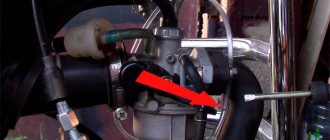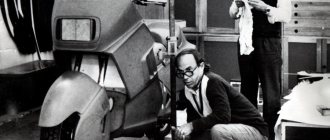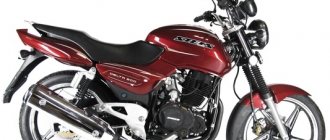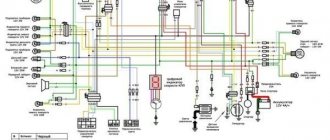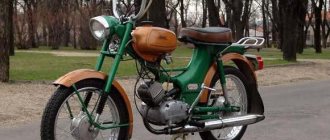A mixture is formed in the carburetor, which then enters the engine; it must be periodically adjusted. The composition comes in three types: normal (ratio 1:15), enriched and depleted. The quality of the connection is determined by the fuel to air ratio. An increase in the amount of air leads to a leaner mixture .
As a result of this, consumption can be minimized, but maximum power cannot be achieved. Reducing the amount of air leads to a richer mixture. With a ratio of 1:12.5 or 1:13, the engine is able to operate at maximum efficiency, but gasoline consumption increases significantly.
The delta moped carburetor is adjusted in the following order:
- The engine is pre-warmed. You can make adjustments after a trip, when the engine is already well warmed up.
- Before making adjustments, it is advisable to replace the spark plug, clean the air filter, look at the exhaust system and clean it. The carburetor channels must be washed and blown with air.
- The screw that regulates the quality of the mixture is tightened all the way and returned ½ turn back.
- The minimum stable rotation of the crankshaft is set by turning the idle screw. By turning the quality screw, the air ratio is increased until interruptions in engine operation begin.
- Using the idle screw, stable engine operation is restored.
- The quality screw is turned again. This reduces the rotation speed. The previous steps are repeated until a minimum stable crankshaft speed is obtained.
- The result of regulation is checked by closing the throttle. If the engine stops, the mixture must be leaner, and if it stalls, it must be enriched. Most often, the quality screw needs to be turned ¼ or ½ turn.
It is also necessary to periodically check the condition of the damper to ensure there is no deformation. To do this, check the condition of the damper in the open and closed positions. In normal condition, the damper should be at an angle of 60°-70°.
Not only the performance of the engine, but also its power and fuel consumption depend on the correctly adjusted operation of the carburetor. Both rich and lean mixtures negatively affect engine wear, the frequency of replacing spark plugs, and the condition of the exhaust system. Correct carburetor regulation can be monitored by the condition of the spark plug.
If the candle is brown, then the mixture is normal, if it is black, the mixture is enriched and needs to be depleted to normal, if white, the mixture is lean and needs enrichment. A properly adjusted carburetor ensures minimal gasoline consumption without loss of engine power.
Carburetor adjustments should not be made indoors. During operation, exhaust gases will be released, which are very poisonous to the body. Garage doors must be open, otherwise serious poisoning can occur.
A mixture is formed in the carburetor, which then enters the engine; it must be periodically adjusted. The composition comes in three types: normal (ratio 1:15), enriched and depleted. The quality of the connection is determined by the fuel to air ratio. An increase in the amount of air leads to a leaner mixture .
As a result of this, consumption can be minimized, but maximum power cannot be achieved. Reducing the amount of air leads to a richer mixture. With a ratio of 1:12.5 or 1:13, the engine is able to operate at maximum efficiency, but gasoline consumption increases significantly.
The delta moped carburetor is adjusted in the following order:
- The engine is pre-warmed. You can make adjustments after a trip, when the engine is already well warmed up.
- Before making adjustments, it is advisable to replace the spark plug, clean the air filter, look at the exhaust system and clean it. The carburetor channels must be washed and blown with air.
- The screw that regulates the quality of the mixture is tightened all the way and returned ½ turn back.
- The minimum stable rotation of the crankshaft is set by turning the idle screw. By turning the quality screw, the air ratio is increased until interruptions in engine operation begin.
- Using the idle screw, stable engine operation is restored.
- The quality screw is turned again. This reduces the rotation speed. The previous steps are repeated until a minimum stable crankshaft speed is obtained.
- The result of regulation is checked by closing the throttle. If the engine stops, the mixture must be leaner, and if it stalls, it must be enriched. Most often, the quality screw needs to be turned ¼ or ½ turn.
It is also necessary to periodically check the condition of the damper to ensure there is no deformation. To do this, check the condition of the damper in the open and closed positions. In normal condition, the damper should be at an angle of 60°-70°.
Not only the performance of the engine, but also its power and fuel consumption depend on the correctly adjusted operation of the carburetor. Both rich and lean mixtures negatively affect engine wear, the frequency of replacing spark plugs, and the condition of the exhaust system. Correct carburetor regulation can be monitored by the condition of the spark plug.
If the candle is brown, then the mixture is normal, if it is black, the mixture is enriched and needs to be depleted to normal, if white, the mixture is lean and needs enrichment. A properly adjusted carburetor ensures minimal gasoline consumption without loss of engine power.
Carburetor adjustments should not be made indoors. During operation, exhaust gases will be released, which are very poisonous to the body. Garage doors must be open, otherwise serious poisoning can occur.
Debriefing, or Adjusting the carburetor unit of the Alpha moped
After the moped has been run-in, a full cycle of technical inspection is carried out, which includes changing the oil in the transmission and engine, as well as adjusting the valve clearance. In addition, the manufacturer recommends replacing the air filter element. During operation, disturbances in dynamics are possible, requiring individual adjustment of the carburetor on an Alpha moped. Qualified adjustment of this unit will improve driving performance and help reduce fuel costs. This operation is similar to adjusting the carburetor on a scooter and will not cause much trouble for both beginners and experienced motorcyclists.
Setting up the carburetor in a Suzuki Sepia scooter
The Japanese scooter Suzuki Sepia is considered a fairly popular model in Russia and other countries, in particular due to its attractive appearance and simple design of the engine and other parts. But problems with this scooter are quite frequent and are caused by malfunctions of such components as the CPG, carburetor and variator
It is important to carefully monitor their condition to prevent damage. As for the carburetor, the Mikuni carburetor is used here, the Suzuki Sepia is ideal for this carburetor model, which is also used on other vehicles
In particular, you can see a similar model on the no less famous Suzuki Adress scooter. The carburetor is characterized by its simple design, good quality and the ability to quickly adjust. But judging by the frequent problems of owners, it will be extremely difficult to adjust the carburetor for optimal operation of the scooter; the entire procedure will have to be carried out exactly according to the specified rules. If you are the owner of a Suzuki Sepia, get ready to clean the carburetor frequently, because its location is so inconvenient that the carburetor becomes clogged with dust very often. Below is a carburetor setting option.
Signs that require an urgent check of the carburetor
Most motorists know the principle of operation of the carburetor unit and the necessary conditions for its stable operation. The main indicator for the full functioning of the engine is the composition of the combustible mixture, which should consist of 15 parts air and 1 part gasoline. Violation of the ratio leads to enrichment or, conversely, to depletion of the composition.
The main signs of a lean mixture:
- instability XX;
- difficult starting;
- popping sounds in the carburetor;
- the engine does not gain momentum;
- white carbon deposits on the candle.
Why do you need to regulate?
During the adjustment process, the scooter carburetor needle is adjusted, the position of which affects the proportions of the air-fuel mixture, as well as a number of other adjustments.
Adjusting the scooter carburetor needle is done during the adjustment process
Each tuning operation has a different effect on engine operation and fuel preparation:
- adjusting the idle speed ensures stable operation of a running engine when the transmission is turned off;
- changing the quality of the air-gasoline mixture using a special screw allows you to deplete or enrich it;
- adjusting the position of the carburetor needle affects the change in the quality of the fuel mixture;
- Ensuring a stable level of gasoline inside the float chamber avoids flooding of spark plugs.
A power unit with an adjusted carburetor operates stably in any conditions, is economical, throttle response, develops rated power and maintains speed, and does not cause problems for its owner.
Adjustment procedure
Proper engine operation depends on compliance with operating rules and strict compliance with technical inspection requirements. Before you start setting up the carburetor on the Alpha moped, you need to first carry out a number of works:
- Clean the carburetor body.
- Replace the spark plug.
- Replace the air filter.
- Make sure the connections are tight.
Now you need to accurately set the gasoline level in the float chamber by bending the float tongue. By connecting a transparent hose to the drain fitting, it is possible to determine the absolute fuel level. To do this, the hose is lifted up. Typically the height is at the junction of the carburetor caps.
The next step is to adjust the idle speed system using quantity and quality screws. The whole process takes place on a warm engine. The quality screw is screwed in until it stops and then unscrewed two turns. Start the engine and, by rotating this screw in both directions, achieve maximum speed. Then use the quantity screw to reduce the speed to the minimum stable speed. It is possible that the procedure may need to be repeated several times until the desired result is achieved.
Adjustment of the middle speed range occurs by raising or lowering the needle. To do this, you need to unscrew the throttle nut, remove the needle and move the corkscrew into one of the grooves: above the middle division to lean the mixture and below to enrich it.
High-quality engine operation at high speeds is ensured by the size of the main jet
. Therefore, setting up the carburetor on an Alpha moped will be completed only after selecting the appropriate jet number. If the carburetor produced a lean composition, then it is worth installing a part with a higher throughput. To lean the mixture, you need to do exactly the opposite - set a lower number.
You can check the accuracy of the settings by inspecting the spark plug insulator. If it is light or brown in color without carbon deposits, then the system is adjusted normally. If the threads and insulator of the spark plug are smoked with black soot, the mixture should be adjusted to medium speed.
Maintenance Procedure
Scooter motors are manufactured in different volumes. The most common are 50 and 150 cubic meters. The gas distribution system has both 2t and 4t options. The differences between the models are minimal, so maintenance of 2 and 4 stroke 50cc mopeds is carried out according to the same principle.
- Carburetor adjustment at idle speed. The scooter starts and its operation without load is analyzed. The assessment is carried out based on the evenness of the strokes and the stability of the engine speed.
- The position of the screws for the quantity and quality of the mixture is adjusted.
Due to the relative lightness of the structure, adjustment is made with two control bolts. If stable operation cannot be achieved, it is necessary to remove the unit and carry out deep cleaning and adjustment.
Important: before servicing the carburetor on a 4t and 2t scooter, you should make sure that the piston group and ignition system are in good condition. Otherwise, the adjustment will have no effect.
Because of the way it works, the carburetor is attached directly to the intake manifold. The fuel line and air duct are connected to it. All removable hoses are removed from the body and the part is exposed.
The starting enrichment is switched off. The fastening bolts are unscrewed with a spanner wrench, and the entire assembly is pulled out.
Installation is in the reverse order.
Carburetor cleaning
An excellent cleaning method is to blow out the internal channels with compressed air from a compressor. For this, a special gun with a pointed tip is used.
During operation, plaque forms on the surfaces of the carburetor. This is due to the quality of gasoline. Most of the dirt stops in the fuel filter, but some gets into the intake tract.
To remove deposits, you can use either a solvent or a special liquid for cleaning carburetors. It is also suitable for scooters. The advantage of using it is that the cleaning agent is under pressure and is able to penetrate into the most inaccessible channels.
The scooter carburetor has rubber gaskets. To avoid exposing them to cleaning mixtures, it is recommended to insulate these parts in advance.
When cleaning the intake mechanism of a scooter, it is not recommended to use fluffy rags. Their threads can get stuck in the carburetor components, which will lead to additional difficulties.
Idle speed adjustment
An indicator of proper operation of the carburetor on a scooter is a stable idle. The absence of “floating” speeds and confident operation indicate a prepared mixture inside the combustion chamber.
For this purpose, there is a screw on the device that is responsible for dosing fuel when the scooter is operating without load.
Some carburetors do not have adjustment bolts. In this case, you need to adjust the idle mode using a needle and floats in the fuel chamber.
The scooter is started and allowed to run for a few minutes. This is necessary for better evaporation of gasoline inside the intake manifold and its mixing with air.
After warming up, turn the idle screw until the engine becomes stable. The criteria for correct adjustment are:
- the scooter maintains stable speed indicators;
- there is no engine tremors or failures in operation;
- the carburetor confidently switches to power gain mode (when over-throttled) and back.
Sometimes the scooter refuses to respond to idle adjustment. This behavior indicates additional problems in the intake system.
Mix quality
The two main components in the operation of any internal combustion engine are air and fuel. The force from their combustion pushes the pistons and forces the vehicle to move.
But simply mixing these substances is not enough. You can achieve maximum energy output only by maintaining the correct proportion of components. In a carburetor, this procedure is called adjusting the quality of the mixture and the entire operation of the 50cc scooter depends on it.
There are three types of air-fuel mass:
Maintaining the correct mixture ratio in the carburetor is vital for reliable engine operation.
Mixture control diagram
First, you need to start the scooter and warm it up. After setting the temperature, you should proceed according to the following algorithm:
- The mixture quality screw is tightened until it stops.
- Loosen the adjusting bolt one and a half turns counterclockwise.
- Start the scooter, tighten the screw a third.
- If the speed increases, turn it a quarter.
- We adjust until the speed stops falling.
This scheme allows you to configure all types of motorcycles.
How to adjust the carburetor on an Alpha moped
Most mopeds have a very simple carburetor design; it is also located in a convenient location, which makes it possible to quickly adjust. And if you are the owner of an Alfa moped and the like, this guide is about how to set up a carburetor on an Alfa moped for you.
Carburetor adjustment is necessary for most mopeds, because over time, precise settings are lost, and it becomes necessary to improve idle speed or fuel consumption. This need may arise when the Alpha moped begins to function incorrectly, producing a completely different fuel mixture. The standard ratio of gasoline to air should be 1 to 15. Deviation from the norm leads to the mixture becoming richer or leaner.
When a rich mixture forms, you will experience the following symptoms:
- frequent popping noises in the exhaust pipe;
- weak acceleration dynamics;
- high fuel consumption.
Signs of a lean mixture include:
- the presence of white carbon deposits on the candle;
- difficulty starting the engine;
- poor idle speed;
- inability to increase speed.
If you do not know how to adjust the carburetor on an alpha 50 or 110 cc moped, perform all the steps in sequence, but before doing this, make sure that the engine is properly warmed up. After this, you will have to perform the following steps to fine-tune the carburetor:
- replace or clean the air filter;
- check the spark plug;
- clean the surface of the carburetor from dirt;
- Check all hoses and connections for leaks.
Tuning the carburetor of a two-stroke engine
One of the main components in the fuel mixture supply mechanism in a vehicle such as a scooter is the carburetor. Before moving directly to the description of the adjustment process, let's talk about why it is needed at all.
Carburetor - a device that ensures the formation and supply of a fuel mixture (consisting of air, gasoline and oil) directly to the engine
What exactly is the purpose of a carburetor? In a nutshell, this is a device that ensures the formation and supply of a fuel mixture (consisting of air, gasoline and oil) directly to the engine. That is, the quality of this mixture and, accordingly, the power that the power unit produces depends on it.
Scooters typically use carburetors of a type called “float” carburetors. The main element is a Venturi tube, which houses a damper that regulates the amount of air supplied to the mixture, as well as a needle that supplies gasoline. By unscrewing the throttle, we thereby open the throttle and raise the needle, increasing the amount of air-fuel mixture entering the engine.
Naturally, the movements of the valve and the needle must be clearly synchronized to ensure its (mixture) homogeneity. The float chamber is designed to ensure the constant presence of gasoline in the tube. The principle of its operation is based on the fact that when the fuel level drops, the float lowers and opens a channel for supplying gasoline to the tube. When it is full, the float rises and closes the valve, thereby stopping the flow of fuel.
If the scooter's engine power drops, it is impossible to start the engine or the engine stalls - these are signs of a carburetor failure
Signs that the carburetor is faulty may include:
- Engine power drop
- Inability to start the engine
- The engine stalls.
Another way to assess the quality of the carburetor (more precisely, the correctness of its operation) is as follows - unscrew the spark plug and look at its color. If it is white, it means the fuel mixture is lean, that is, there is too much air in it, and if the spark plugs have a black tint, it means the carburetor is “pouring” too much fuel. With any of these options, one thing is clear - it needs adjustment.
It should be noted that, globally, this process does not depend on the engine stroke, therefore the answer to the question of how to correctly adjust the carburetor on a Chinese 4t scooter and how to correctly adjust the carburetor on a 2t scooter will be the same. Let's now move on to describing the sequence of actions.
How to properly adjust the carburetor on an alpha moped
Step 1. Setting the mixture quality. The Alpha moped has a special screw for this, which must first be fully tightened and unscrewed a maximum of 1 turn. Next, we find the idle speed screw and rotate it until the moped begins to operate stably at normal speeds. The next stage is to lean the mixture; after idling, you will have to slightly unscrew the mixture quality screw until the engine begins to work poorly intermittently.
Step 2. We made the mixture lean, but we need to fix this; to do this, we enrich the mixture with the idle screw, tightening it. The adjustment continues until the motor starts working normally and without interruption. You can check that the carburetor of the Alpha moped is adjusted by pressing the gas handle. If, when it is opened abruptly, the engine immediately stalls or choke, you will have to enrich the mixture by slightly unscrewing the mixture quality screw.
Purpose and principle of operation of the carburetor
The carburetor is an important component of an internal combustion engine, responsible for preparing the air-fuel mixture and supplying it to the working cylinder in the required ratio. A scooter engine with an unadjusted carburetor cannot function properly. The stability of speed, the power developed by the engine, gasoline consumption, response to turning the throttle, as well as ease of starting in the cold season depend on the correct settings of the engine power supply.
This unit is responsible for preparing the air-gasoline mixture, the concentration of the components of which affects the nature of the operation of the power plant. The standard ratio is 1:15. Leaning the mixture to a ratio of 1:13 ensures stable engine operation at idle. Sometimes it also becomes necessary to enrich the mixture by maintaining a ratio of 1:17.
Knowing the structure of the carburetor and knowing how to adjust it, you can ensure stable operation of the engine on two-stroke and four-stroke scooters.
Thanks to a properly configured carburetor, easy and quick starting of the vehicle engine is ensured, as well as stable operation of the engine, regardless of the ambient temperature. Any carburetor is equipped with jets with calibrated holes, a float chamber, a needle that regulates the cross-section of the fuel channel, as well as special adjusting screws.
The adjustment process involves specially rotating the screw in a clockwise direction or in the opposite direction, which causes, respectively, the enrichment or depletion of the working mixture. Adjustment measures are carried out on a warmed-up engine. In this case, the carburetor unit must first be thoroughly washed and cleared of blockages.
How to set up a carburetor on an Alpha
On my moped it was possible to adjust the spark plug insulator only by checking it. Normal settings at 2.5-3 full turns of unscrewing the quality screw (2.5 turns is the minimum at which the soot stopped appearing) MY ENGINE STALLED WHEN CLOSING THE THROTTLE SHARPLY AND I NEEDED TO LEAN THE MIXTURE (AND I MIXED IT UP AND ENRICHED IT)
Next, after all that has been done, we drive the scooter for several kilometers as usual, unscrew the spark plug and visually determine by the color of the spark plug insulator what mixture the carburetor is “preparing.”
If the spark plug insulator is black and covered with a layer of soot, then the carburetor is “preparing” a “rich” mixture, in this case the situation can be corrected by UNLOCKING THE QUALITY SCREW (if this does not help, then lowering the carburetor needle to the desired division.)
It must be remembered that the reason for the enrichment of the scooter mixture can be not only incorrect carburetor settings, but also a dirty scooter air filter; and the cause of a lean mixture may be the scooter’s fuel system clogged with dirt.
Mopeds Delta, Alpha and similar clones with CUB engines.
We discuss Delta, Alpha and similar mopeds: maintenance, repair, tuning, styling of mopeds. "Viper" : Delta, Alpha; Chongqing Wonjan motorcycle (Chongqing Wonjian) “Alphamoto” : Farmer, Pony; "Zonder" : Fisher, Wolf; "Kanuni" : Nostalgia, Savage; "Lifan" : LF50Q-2, LF50; "Mustang" :YX48Q, YX48Q-2; "Atlant" : City; "SOUL" : Farmer;
Characteristics of CUB engine 50, 70, 90, 100, 110, 125 cc. Judging by the graphs, the most optimal 110cc engine: TYNTS
Useful video on repairing our engines:
In the archives:
I increased the level in the float chamber, now in an inverted position the float is parallel to the body, from the factory it stuck out 2-3 degrees upward (the level was a little lower) The spark plug is black and wet. I checked the suction everywhere, everything seems to be in order. The throttle valve works perfectly. Gasoline seems to flow into the carb, the fuel filter is always full. The problem starts when I drive 2 kilometers. Before that it works like a clock, then it starts to sneeze into the silencer at low speeds. At idle it works stably and suddenly it can stall stupidly and then won’t start for a couple of minutes. After a couple of minutes it will start and drive, but still at low speeds it jerks violently and sneezes. Give the gas sharply and steadily gain momentum. On medium it works stably. The problem is only at idle. It seems like he doesn't want to drive slowly. After 55 km/h it starts to work stably, but how long does it take for it to run in? When the engine is hot, a knocking sound appears in the valves, although on the contrary it should disappear. I checked the gap on both valves, both 005. I tried adjusting it with the quality screw. I unscrewed it two turns and tightened it a little bit along the way. It got to the point where I just cranked it up and nothing changed; at idle it only started to stall sometimes. When cold, the carb is regulated well, with the quality screw I set the maximum speed, or rather, it becomes maximum. but as soon as it warms up, no matter how you turn it, it doesn’t matter, the speeds are the same.
Tell me, how to set the fuel level correctly, how to control it? How to lean the mixture, a quality screw or a needle in the damper?
Soot contamination
Type of spark plug: dry soft soot of intense black color on the insulator, electrodes and spark plug body.
Consequences: poor start of the scooter engine; poor operation of a cold scooter engine; interruptions in ignition of the air-fuel mixture; bad reaction to gas.
Probable causes: excessively rich air-fuel mixture; The scooter's air filter is very clogged; The thermal range is incorrectly selected - the candle is too “cold”.
Remedy: adjust the working mixture; adjust the cold start system of the scooter engine; change the scooter air filter; clean the spark plugs or replace them with new ones - with the correct heat rating.
Setting the mixture quality
The quality of the mixture plays a key role in the operation of the entire scooter, because incorrectly configured parameters will lead to the scooter choking, consuming a lot of fuel and increasing wear on the piston group. That is why the combustible mixture must be in the optimal quantity; a lean mixture indicates a loss of power and frequent overheating of the engine, a rich mixture is characterized by high fuel consumption and the presence of heavy carbon deposits in the combustion chamber.
There are two ways to adjust the quality of the mixture - with an adjusting screw or the needle level in the damper. In some cases, the carburetor design assumes the absence of an adjusting screw, so adjustment is carried out only with a needle. The standard procedure for adjusting the screw is to rotate counterclockwise and clockwise; in the first case, the mixture becomes lean; tightening the screw indicates that the mixture is richer. In the case of a needle, you can enrich the mixture by raising it up; the lean mixture is set on a lowered needle.
Important: adjusting the quality of the mixture should also be carried out with the engine warmed up for 10-15 minutes. The instructions for most scooters say that there is a standard mixture quality setting, where the screw should be unscrewed only 1.5-2 turns
Therefore, if it is impossible to accurately adjust the mixture, stick to this indicator
The instructions for most scooters say that there is a standard setting for the mixture quality, where the screw should be unscrewed only 1.5-2 turns. Therefore, if it is impossible to accurately adjust the mixture, stick to this indicator.
The needle is adjusted by raising or lowering it; it has markings and a special locking ring that sets the current height. Accordingly, if you find a lean mixture, you will have to raise the ring level by 1 notch. Having achieved optimal performance, your scooter will operate smoothly and correctly, it will consume fuel in normal quantities, and the power will correspond to the characteristics.
Oil contamination
Type of spark plug: wet oily black deposits on the insulator, black oil deposits on the insulator, electrodes and spark plug body.
Consequences: poor start of the scooter engine, interruptions in ignition.
Probable causes: too much oil in the fuel mixture (for two-stroke engines); wear of the rings and/or piston liner - wastes oil.
Remedy: mix gasoline and oil in the correct proportion, install new spark plugs for the scooter (for two-stroke engines); inspect the condition of the scooter engine, if necessary, repair the engine, CPG; .
Carburetor structure
It is worth noting that the location of the carburetor is also different in different scooter models. Therefore, before you start adjusting it, you need to thoroughly study all the components and assemblies of your vehicle, their characteristics and location. The structure, in contrast to the location, of the carburetor is approximately the same.
The carburetor includes the following components:
- Venturi tube;
- valve with needle;
- float chamber;
- idle system;
- starting enrichment;
- spool;
- accelerator pump.
Venturi tube
So, the first element of the carburetor, called the Venturi tube, plays the most important role in its operation. This part is characterized by a diameter that varies throughout the entire length of the tube. This is due to the fact that it narrows towards the center, after which expansion follows again. It is the narrowest point of the tube that is intended for the air flow to pass through it.
The characteristic narrowing of the tube contributes to the formation of low air pressure, which is aligned to the point of expansion of the tube. If another smaller tube with gasoline is placed inside this tube, then the gasoline, on its way to the low-pressure zone, will begin to leave the small tube, spraying and evaporating, interacting with the air flow inside the large tube.
Flap with needle
The valve with the needle is installed directly in the center of the Venturi tube described above. It is necessary in order to regulate the amount of mixture that enters the combustion chamber. This adjustment is carried out by pressing the gas. However, the damper cannot operate without a needle. It is this that determines the volume of fuel entering the engine. So, when the pilot presses on the gas, the damper begins to move, thereby raising the needle, due to which the required amount of gasoline is supplied. In a word, the harder you press on the accelerator pedal, the more the damper opens, and, accordingly, the more fuel enters the combustion chamber.
Float chamber
To prevent the engine from stalling, it must be constantly supplied with fuel, a certain amount of which must be in the tube. For this purpose, a float chamber was invented, the operation of which is carried out on the principle of a toilet tank. Those. There is a float inside the chamber that moves to its lower part immediately after the gasoline level in the tube drops. Thus, the displacement of the float ensures the opening of a special valve through which fuel enters. After filling, the float rises, thereby closing the valve. This ensures a continuous and correct supply of fuel.
Idle system
The idle system in the carburetor is responsible for idling. However, its work is carried out not only at idle, but also at low speeds. In the case of idle speed, fuel is supplied through another channel of the carburetor, which is located behind the limiter. The idle system consists of:
Screw system
It is responsible for the volume of air that passes through the entire system, thereby regulating the quality of the mixture entering the combustion chamber. By tightening and unscrewing this screw, the pilot can adjust the amount of air. Accordingly, the less air volume enters the system, the tighter the screw is tightened, and vice versa. It turns out that when there is a lot of air, the fuel is leaner, when there is little, it is richer, since it contains more gasoline than air.
Special channel
The fuel mixture leaves the carburetor through it. This channel is closed by a special valve at the moment when the carburetor throttle valve opens
The valve is an important part because it prevents the system from negatively affecting the operation of the scooter's power unit at high speeds
How to adjust the carburetor on an Alpha moped
Most mopeds have a very simple carburetor design; it is also located in a convenient location, which makes it possible to quickly adjust. And if you are the owner of an Alfa moped and the like, this guide is about how to set up a carburetor on an Alfa moped for you.
Carburetor adjustment is necessary for most mopeds, because over time, precise settings are lost, and it becomes necessary to improve idle speed or fuel consumption. This need may arise when the Alpha moped begins to function incorrectly, producing a completely different fuel mixture. The standard ratio of gasoline to air should be 1 to 15. Deviation from the norm leads to the mixture becoming richer or leaner.
When a rich mixture forms, you will experience the following symptoms:
- frequent popping noises in the exhaust pipe;
- weak acceleration dynamics;
- high fuel consumption.
Signs of a lean mixture include:
- the presence of white carbon deposits on the candle;
- difficulty starting the engine;
- poor idle speed;
- inability to increase speed.
If you do not know how to adjust the carburetor on an alpha 50 or 110 cc moped, perform all the steps in sequence, but before doing this, make sure that the engine is properly warmed up. After this, you will have to perform the following steps to fine-tune the carburetor:
- replace or clean the air filter;
- check the spark plug;
- clean the surface of the carburetor from dirt;
- Check all hoses and connections for leaks.
How to properly adjust the carburetor on an alpha moped
Step 1. Setting the mixture quality. The Alpha moped has a special screw for this, which must first be fully tightened and unscrewed a maximum of 1 turn. Next, we find the idle speed screw and rotate it until the moped begins to operate stably at normal speeds. The next stage is to lean the mixture; after idling, you will have to slightly unscrew the mixture quality screw until the engine begins to work poorly intermittently.
Step 2. We made the mixture lean, but we need to fix this; to do this, we enrich the mixture with the idle screw, tightening it. The adjustment continues until the motor starts working normally and without interruption. You can check that the carburetor of the Alpha moped is adjusted by pressing the gas handle. If, when it is opened abruptly, the engine immediately stalls or choke, you will have to enrich the mixture by slightly unscrewing the mixture quality screw.
Many people sooner or later face, for some reason, the need to adjust the carburetor. But not everyone knows how to do it correctly. This article may be useful to you in such a situation. At first glance, a carburetor looks like a complex device, but with a little theory, it will be easier for you to adjust it. The first thing you need to know is at least the basics of the principle of operation of the carburetor and its main controls and adjustments. Let's start with the basics.
Let's look at the principle of operation of a carburetor using the example of Figure 1:
The opening in the carburetor through which the air-fuel mixture (the mixture that ignites in the combustion chamber and causes the piston to move up and down) is supplied to the intake manifold, as shown in the figure by arrow 1 (the intake manifold is the pipe connecting the carburetor to the engine) and then enters combustion chamber. When the engine is running, the pressure in the intake manifold decreases relative to atmospheric pressure, which also leads to a decrease in pressure in the carburetor. Naturally, since the atmospheric pressure is higher, air will begin to flow into it from the side of the carburetor, shown by the blue arrow, and, accordingly, through the intake manifold and bypass channels into the combustion chamber. Air passing through the carburetor will pick up fuel from the fuel chamber and mix with it, thereby creating a combustible air-fuel mixture. Figure 1 shows that air enters the carburetor through a gradually narrowing channel. It is like a river bed. You've probably noticed that in the place where the river narrows, the current increases. The same thing happens in the carburetor: the movement of air accelerates, which leads to even greater discharge. The chamber where the fuel is located is connected to the atmosphere, so the pressure in it is higher, and the fuel rises through the tube and mixes with air. The result is a fuel-air combustible mixture. The lower the pressure in the carburetor, the more fuel enters and mixes with air. Now let's go deeper. How to regulate the supply of fuel with air? You've probably all noticed that there is a gas handle on the right side of the scooter's steering wheel? :o) So she controls the carburetor. Consider Figure 2 below:
The throttle handle on the steering wheel is directly connected to the air damper and the metering needle attached to it. When the gas is released, the needle almost completely blocks the fuel supply channel from the float chamber (why it is a float chamber, we will explain below) and the air damper blocks the air.
Thursday, September 28, 2022
Carburetor diagram for 139qmb
Check all O-rings for damage. Replace if necessary.
When cleaning the carburetor, remove the vacuum diaphragm before using purge air or cleaning solvents. This will prevent damage to the diaphragm.
Possible malfunctions of the CVK carburetor
1.The engine is difficult to start
— No spark - Poor compression
2. There is no fuel in the carburetor
-Closed fuel line -Closed fuel filter -Blocked vacuum line -Damaged Broken vacuum line -Clogged inlet needle -Float level set too high
3. Too much fuel for the engine
-Dirty air filter -Air leak in the manifold -Faulty enrichment valve -Blocked air passage in the carburetor
4. Air/fuel mixture too rich or too pale
-Faulty enrichment valve -Tightened idle screw -Float needle stuck or dirty -Float height too high or too low -Blocked carburetor air passage -Dirty air filter -Carburetor or manifold air leak
5. Engine does not accelerate
-Bad spark -Air mixture screw too tight -Accelerator pump faulty
6. Almost does not respond to the throttle
-Weak spark/poor ignition -Blocked fuel line -Blocked fuel filter -Bad fuel -Water in fuel -Air leak in carburetor or manifold -Faulty enrichment valve -Fuel flow difficult in carburetor -Vacuum choke stuck -Damaged vacuum diaphragm -Dirt in carburetor
Removing the carburetor
1. Remove the seat and container underneath. 2. Remove the right side panel. 3. Disconnect the starter cable connector. 4. Loosen the carburetor drain screw and drain the fuel from the float chamber. 5. Loosen the clamps in the intake pipe and intake manifold. 6. Loosen the throttle cable and pull it out of the caliper and out of the throttle control sector. 7. Disconnect the fuel line from the carburetor. 8. Remove the air intake tube and pull the carburetor straight back out of the intake manifold. 9. Remove the starter enricher from the carburetor.
Checking the enrichment valve
1. Check the resistance level. 2. The standard value is below 5 if it is cold. 3. Connect the enricher to a 12 V battery. 4. The plunger should extend 3/8 inch (approximately 10 mm) after 5 minutes.
5. Check the needle and its working place in the carburetor. 6. Replace if necessary. 7. Place the enrichment valve in the installation location and press down. 8. Install the retaining ring and tighten the screws.
Air shut-off valve
1. Unscrew the two screws of the traverse, the throttle cable, and remove it. 2. Unscrew the two screws of the air shut-off valve. 3. Remove the spring and vacuum membrane. 4. Check for membrane wear, replace if necessary. 5. Clean the channels, remove dirt.
Vacuum chamber
1. Remove two screws and remove the cover. 2. Remove the spring and membrane flap. 3. Remove the fuel needle. Be especially careful not to damage the membrane. Replace if damaged.
1. Check the needle for wear and replace if necessary.
Float chamber.
1. Remove the three screws and float chamber pan. 2. Remove the pin that holds the float. 3. Remove the main fuel jet, idle speed jet and idle mixture quality adjustment screw.
Be careful not to break the fuel jets and mixture screw. Count the number of revolutions when removing the mixture quality screw. When reinstalling the jets and screw, do not tighten them.
4. Clean the jets with solvent and compressed air. 5. Clean the carburetor body and all passages with compressed air.
1. Check the float needle and its seat and blow off any dirt. 2. Install the idle jet, fuel needle nozzle, main fuel jet into the carburetor.
3. Install the float. Adjust the fuel quality screw. Standard setting is 2 turns, plus or minus 1/4 turn. 4. After installing the float chamber pan, check the fuel level using a small ruler or calibrator. The correct fuel level is 20.5 mm (0.807 in).


